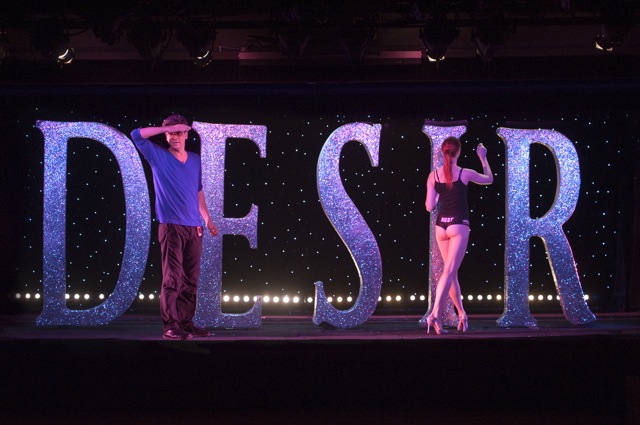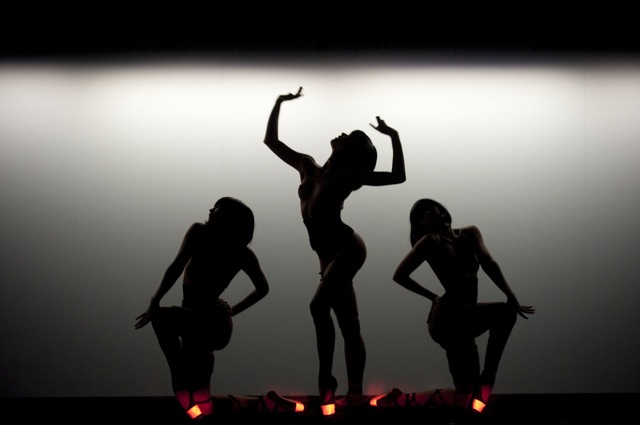CHICAGO – Patrick McDonald of HollywoodChicago.com appears on “The Morning Mess” with Dan Baker on WBGR-FM (Monroe, Wisconsin) on March 21st, 2024, reviewing the new streaming series “Manhunt” – based on the bestseller by James L. Swanson – currently streaming on Apple TV+.
‘Crazy Horse’ Basks in the Artful Sensuality of Scintillating Dancers
 Rating: 3.5/5.0 |
CHICAGO – A simple glance at the premise of “Crazy Horse” may cause skeptical viewers to dismiss the film as a two-hour peep show. What could possibly be gleaned from endless footage of near-nude Parisian burlesque performers apart from diverting titillation? Yet under the lens of legendary filmmaker Frederick Wiseman, the footage becomes something else entirely.
Though Wiseman (of “Titicut Follies” fame) detests the term “cinéma vérité,” he is inarguably one of the grand masters of the fly-on-the-wall documentary. His signature style forbids any use of narration, staged sequences or contrived talking heads. The one reason human subjects are interviewed in a Wiseman film is because someone else decided to interview them. Favoring intuition and observation over rigorous research, the director peers through his lens with his eyes wide open.
There are moments when Wiseman appears as interested in the combing of wigs and lighting arrangements as he is with the rehearsals themselves. Over a ten-week period, Wiseman and his longtime cinematographer John Davey chronicled the efforts of acclaimed French choreographer Philippe Decouflé to expand his company’s repertoire at Le Crazy Horse de Paris by staging a new show, “DÉSIRS.” The venue’s strenuous schedule requires the dancers to perform two shows a night for seven days a week, with the exception of Saturday (when three shows are staged). One of the first major dialogue scenes occurs during a meeting in which Decouflé argues his points with impassioned theatrical zeal. With deadlines consistently staring him in the face, the choreographer threatens cancellation if he isn’t given enough time to improve his show to the point that it justifies the venue’s reputation as “the best nude dancing show in the world.” The age-old conflict between art and commerce is starkly portrayed in this scene and carries throughout the rest of the picture, as Wiseman repeatedly cuts between the elegant illusions onstage and the tensions that occasionally erupt behind the scenes. Unlike a run-of-the-mill strip club, Crazy Horse aims to impress intellectuals and dance connoisseurs with remarkable routines that blend aspects of ballet and burlesque to transform nude bodies into provocative abstractions.

Philippe Decouflé joins a dancer onstage in Frederick Wiseman’s Crazy Horse.
Photo credit: Antoine Poupel
It’s initially startling to witness how the Crazy Horse’s audience demographic crosses both gender and generational boundaries. When the ticket buyers are first glimpsed at their seats posing for pictures, they appear to be the sort of crowd that would turn out for a Broadway show. Yet once the lights dim and the dancers first materialize, it’s easy to see why their show earns such widespread international appeal. The most striking dance unfolds against a mirror-like surface, as bodies rise from the edge and are reflected to create a plethora of dazzling imagery. The routine is set to a cover of Britney Spears’ “Toxic,” one of several American tunes heard throughout the picture. Decouflé appropriately utilizes Gnarls Barkley’s “Crazy” for background music during a series of auditions. This is one of the rare moments in the film when the Crazy Horse crew—who often tout their love and respect for the female form—come off like a standard stable of heartless casting directors. It’s especially painful to watch the vulnerably naked would-be dancers judged and rejected, while having their features meticulously picked apart (one woman is chosen because of her resemblance to Kate Moss). Wiseman makes the interesting decision to include the full audition of a transsexual dancer whose exuberance is infectious, but his body is unfit for the rigid standards of the judges.
The drawback of Wiseman’s approach is that it doesn’t allow audiences to get to know much about the individual dancers or the history of the establishment, which was founded by Alain Bernardin in 1951. But as in Wim Wenders’ beguiling 3D Oscar nominee “Pina,” the single-minded focus on the performances has its advantages, enabling moviegoers to appreciate the elegance, emotional depth and technical skill of the oft-misunderstood art form. At a running time clocking in around 134 minutes, Wiseman gives the viewer enough room to fully absorb the technique without feeling distracted by the nudity. And though no dancers are directly interviewed on-camera, the film does capture aspects of their behavior backstage. There’s a nice moment when the women cathartically laugh at the videotaped bloopers of a famed Russian dancer, and another where they express their initial misgivings about a dance unfolding onstage. Though the performers are immensely comfortable in their own skin, their “modesty” causes them to draw the line at touching each other, thus forcing Decouflé to axe one of his numbers.

Dancers from The Crazy Horse are featured in Frederick Wiseman’s Crazy Horse.
Photo credit: Antoine Poupel
For critics and auteurs (including Errol Morris) who have deemed his work “misanthropic,” Wiseman’s last three pictures have functioned as an indirect contradiction. 2009’s “La danse,” 2010’s “Boxing Gym” and 2011’s “Crazy Horse” all celebrate the physical abilities and artistic merit of performers, as well as the triumphant survival of their respective institutions. Crazy Horse’s managing director Andrée Deissenberg claims that her venue is one of the only burlesque houses that attracts female audiences. She considers the show’s seductive eroticism—blending “frustration and imagination”—rather empowering. Wiseman allows audiences to judge for themselves, but his awe-struck reaction to the dancer’s hypnotic illusions (mirrored by bookended scenes of a shadow puppeteer) is undeniable.
 | By MATT FAGERHOLM |


